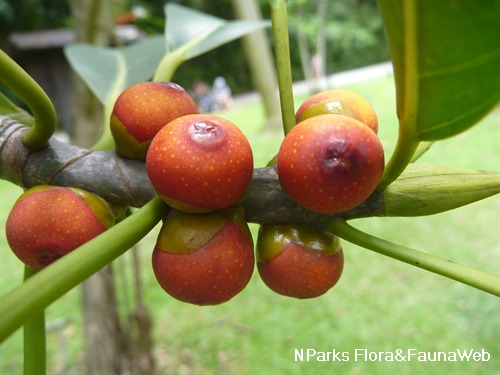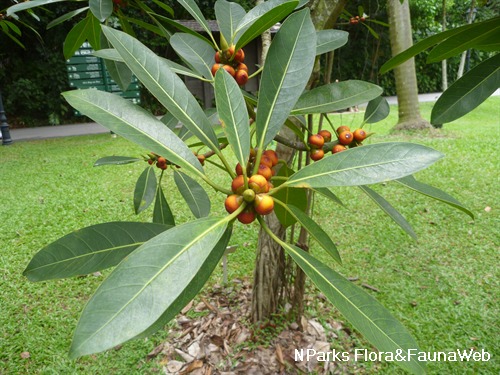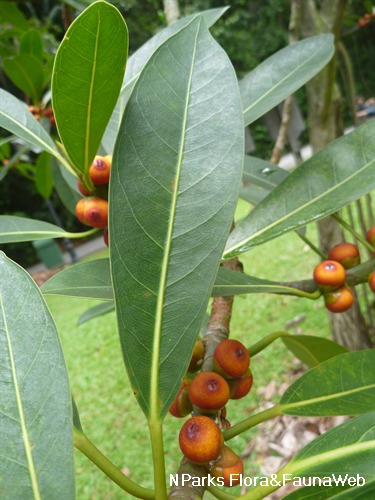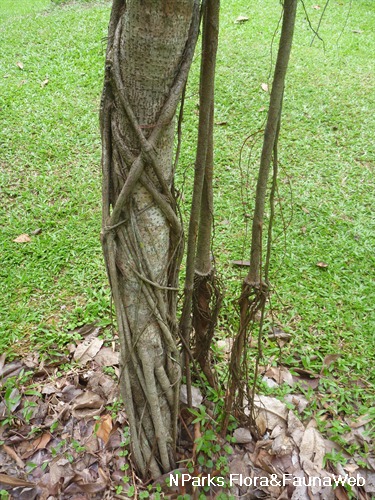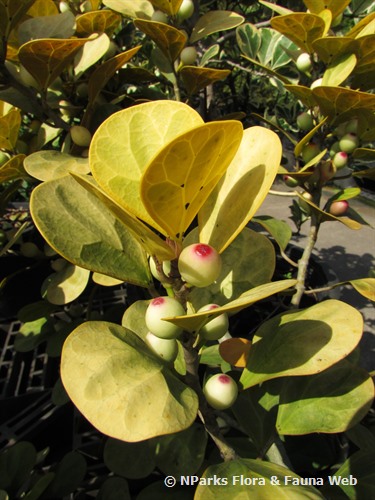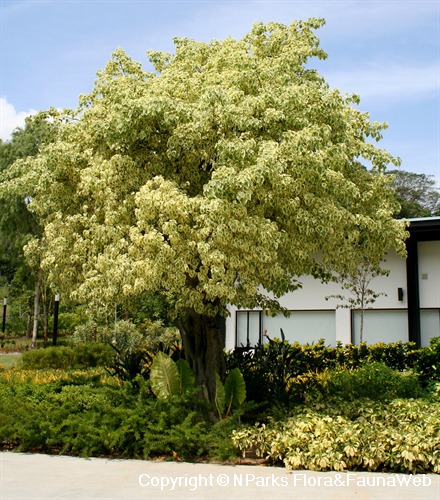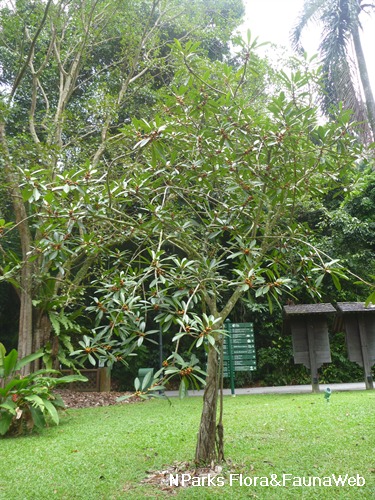
Back
Ficus crassiramea (Miq.) Miq. subsp. crassiramea
| Family Name: | Moraceae |
| Synonyms: | |
| Common Name: | Collared Fig |
Name
Classifications and Characteristics
| Plant Division | Angiosperms (Flowering Seed Plants) (Dicotyledon) |
|---|---|
| Plant Growth Form | Tree (Medium (16m-30m)) |
| Lifespan (in Singapore) | Perennial |
| Mode of Nutrition | Autotrophic |
| Plant Shape | Umbrella, Broad / Mushroom / Hemispherical |
Biogeography
| Native Distribution | Myanmar, Thailand, Sumatra, Peninsular Malaysia, Singapore, the Philippines, Borneo, Java, New Guinea, and the Solomon Islands |
|---|---|
| Native Habitat | Terrestrial (Primary Rainforest, Secondary Rainforest, Coastal Forest) |
| Preferred Climate Zone | Tropical |
| Local Conservation Status | Native to Singapore (Critically Endangered (CR)) |
Description and Ethnobotany
| Growth Form | It is a strangling fig with a broad and spreading crown, up to 30 m tall. |
|---|---|
| Crown | Broad and spreading, umbrella shape. |
| Foliage | Leaves are leathery, spirally arranged, oblong to narrow drop-shaped, measuring between 8–38 cm long by 2.5–16 cm wide. |
| Flowers | Flowers are tiny, enclosed within the syconium (fig). |
| Fruit | The fig is round, partially covered by yellowish green bracts, turns from yellow to dark red coloured upon maturity. Figs are produced along the axils, in pairs or solitary, each measures between 0.8–3.5 cm wide. |
| Habitat | It occurs in forest, often along coast and rivers, at altitudes up to 1500 m. |
| Associated Fauna | The flowers are pollinated by fig wasps. Fruits are eaten by frugivorous birds and mammals. |
| Cultivation | It can be propagated by seed, stem cutting or air-layering. |
| Etymology | Latin Ficus, the commercial edible fig (Ficus carica); Latin crassiramea, thick; Latin ramus, branched, referring to the stout twigs |
| Ethnobotanical Uses | Cultural / Religious: Heritage Trees : There is currently one individual of Ficus crassiramea listed as a Heritage Tree in Singapore. It can be found on Pulau Ubin. To find out more about these trees, please visit the Heritage Tree Register. |
Landscaping Features
| Landscaping | It may be suitable for parks, gardens and roadsides. |
|---|---|
| Desirable Plant Features | Ornamental Fruits |
| Landscape Uses | General, Suitable for Roadsides, Parks & Gardens, Coastal, Shade Providing Tree / Palm |
Fauna, Pollination and Dispersal
| Fauna Pollination Dispersal Associated Fauna | Bird-Attracting (Fruits), Caterpillar Moth Food Plant |
|---|---|
| Pollination Method(s) | Biotic (Fauna) (Insects (Ant, Beetle, Fly, Thrip, Wasp)) |
| Seed or Spore Dispersal | Biotic (Fauna) (Vertebrates (Other Mammal)) |
Plant Care and Propagation
| Light Preference | Full Sun, Semi-Shade |
|---|---|
| Water Preference | Moderate Water |
| Plant Growth Rate | Moderate |
| Rootzone Tolerance | Moist Soils, Well-Drained Soils, Easy to Grow |
| Propagation Method | Seed, Stem Cutting (Softwood), Air-Layering |
Foliar
| Foliage Retention | Evergreen |
|---|---|
| Mature Foliage Colour(s) | Green |
| Mature Foliage Texture(s) | Leathery |
| Foliar Type | Simple / Unifoliate |
| Foliar Arrangement Along Stem | Alternate |
| Foliar Attachment to Stem | Petiolate |
| Foliar Shape(s) | Non-Palm Foliage (Elliptical, Oblong) |
| Foliar Venation | Pinnate / Net |
| Foliar Margin | Entire |
| Foliar Apex - Tip | Acute |
| Foliar Base | Cuneate |
Non - Foliar and Storage
| Trunk Type (Non Palm) | Woody |
|---|---|
| Root Type | Aboveground (Aerial Root), Underground (Tap Root) |
Floral (Angiosperm)
| Flower & Plant Sexuality | Unisexual Flowers , Monoecious |
| Flower Grouping | Cluster / Inflorescence |
|---|
| Flower Location | Axillary |
| Inflorescence Type | Syconium |
Fruit, Seed and Spore
| Mature Fruit Colour(s) | Red, Yellow / Golden |
|---|---|
| Fruit Classification | Multiple Fruit |
| Fruit Type | Fleshy Fruit , Multiple Syconium (receptacle) |
References
| References | Berg. C.C. & Corner. E.J.H (2005). Moraceae: Ficeae. Flora Malesiana, ser. 1 Seed Plants, vol. 17. Leiden: Naturalis Biodiversity Center. |
|---|
Image Repository
Others
| Master ID | 29867 |
|---|---|
| Species ID | 4176 |
| Flora Disclaimer | The information in this website has been compiled from reliable sources, such as reference works on medicinal plants. It is not a substitute for medical advice or treatment and NParks does not purport to provide any medical advice. Readers should always consult his/her physician before using or consuming a plant for medicinal purposes. |

